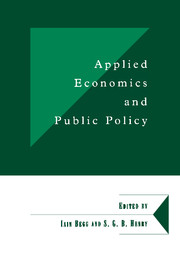Book contents
- Frontmatter
- Contents
- List of figures
- List of tables
- List of contributors
- Foreword
- 1 Introduction
- Part One MODELLING AND FORECASTING METHODS
- Part Two COMBINING DATA AND ANALYTIC TECHNIQUES
- 6 Takeovers, institutional investment and the persistence of profits
- 7 Semi-parametric estimation of the company size–growth relation
- 8 Wage-earnings in Great Britain during the Industrial Revolution
- 9 Company failure and hysteresis
- Part Three USING MODELS TO GUIDE POLICY
- Bibliography
- Index
7 - Semi-parametric estimation of the company size–growth relation
from Part Two - COMBINING DATA AND ANALYTIC TECHNIQUES
Published online by Cambridge University Press: 06 July 2010
- Frontmatter
- Contents
- List of figures
- List of tables
- List of contributors
- Foreword
- 1 Introduction
- Part One MODELLING AND FORECASTING METHODS
- Part Two COMBINING DATA AND ANALYTIC TECHNIQUES
- 6 Takeovers, institutional investment and the persistence of profits
- 7 Semi-parametric estimation of the company size–growth relation
- 8 Wage-earnings in Great Britain during the Industrial Revolution
- 9 Company failure and hysteresis
- Part Three USING MODELS TO GUIDE POLICY
- Bibliography
- Index
Summary
Introduction
In the applied literature, a common finding of studies covering the last 15 years or so has been that firm growth and failure rates decline with firm size and age (Schmalensee, 1989; Hall, 1987; Evans, 1987a,b; Storey et al. 1987; Dunne and Hughes, 1994). This is in contrast to studies covering earlier periods for the United Kingdom which showed that firm growth was positively related to size (Singh and Whittington, 1968,1975; Samuels, 1965; Prais, 1976; Hart, 1965; Kumar, 1984; Samuels and Chesher, 1972). Both sets of studies contradict a celebrated hypothesis attributed to Gibrat which holds that growth is independent of firm size. It has been argued that the result for earlier periods may reflect higher rates of growth by merger amongst larger companies (Hannah and Kay, 1977; Hughes, 1993), whilst the result for more recent years may be attributable to selection bias.
When we estimate size–growth relationships with company panels, an unavoidable problem is sample attrition. Some companies may cease to exist during the period covered by the panel. Whereas slow-growing large firms may simply slip slowly downwards through the size distribution for a considerable length of time before ceasing to trade, a smaller company is likely to hit the boundary of extinction much sooner. Small firms which have slow or negative growth may be more likely to disappear from the sample in any given time interval than are large firms.
- Type
- Chapter
- Information
- Applied Economics and Public Policy , pp. 145 - 180Publisher: Cambridge University PressPrint publication year: 1998
- 1
- Cited by



